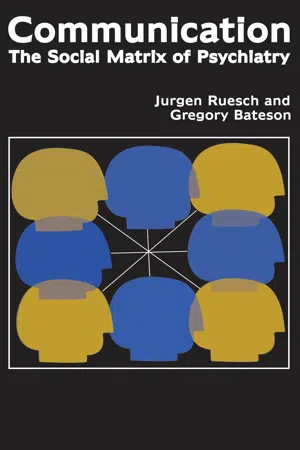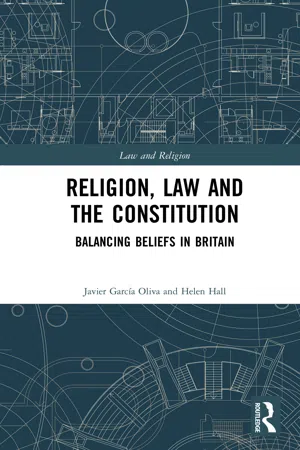Politics & International Relations
Checks and Balances
Checks and balances is a system of government in which each branch has the power to limit the actions of the other branches. This ensures that no one branch becomes too powerful and that each branch is held accountable for its actions. The system is designed to prevent abuse of power and promote accountability.
Written by Perlego with AI-assistance
Related key terms
3 Key excerpts on "Checks and Balances"
- eBook - ePub
Communication
The Social Matrix of Psychiatry
- Jurgen Ruesch, Gregory Bateson, Eve C. Pinsker, Gene Combs(Authors)
- 2017(Publication Date)
- Routledge(Publisher)
ipso facto, making implicit metacommunicative statements about his own position and stock of information: “I lack certain information about my relationship with my followers”; “I feel a need for this information”; “I am deferring to the (to me unknown) opinion of my followers”; and so on.So much for the description of the phenomena. It is now our task to express these observations in a more systematized manner, and we do so by introducing the concept of the system of internal Checks and Balances and the system of external oppositional control. The European viewpoint would be appropriately represented by the system of external control, while the American approach is better exemplified in the system of internal checks. Let us now consider the nature of these concepts.The System of Internal Checks and Balances
Let us consider an American political party or the American form of government, including legislative, executive, and judicial branches, or a welfare organization, or an American university. All of these organizations have features in common which can be conceptualized in a description not intended to fit any specific case but only to illustrate the principles involved:The organization is run by a team, the official representative of which may be called the executive. The latter usually has a staff of administrative assistants who keep in touch with all the other members and departments of the organization. The actions of the executive are checked by the other members of the team, composed of committee members and technical advisers. The executive, the committee members, and the technical advisers divide their duties as follows: the technical advisers are the ones who are most consciously aware of the state of affairs; they are responsible for the collection and interpretation of data relevant to the activities of the organization; they are the scientists, technicians, researchers, and theorists of the organization. The committee members, on the other hand, are the representatives of pressure groups. They represent the constituent groups and hence have the function of checking and counterchecking the whole system; by and large they lack technical knowledge, but possess the “common horse sense” of politicians. The executive, in turn, is the one who keeps the committees in balance and who represents the whole group in relations with the outside world. It is his job to be aware of the tensions within the organization, and he must try to remedy disturbances which might break up the coalition. In most American organizations, if large enough, it is customary to have also a sample of the outside world represented within the organization. This representation is found in the board of supervisors or board of trustees, who represent the citizenship or membership at large. They act as a check upon the pressure groups as represented by the committee members and personified in the executive. If all groups interact appropriately, the success of the organization is assured. If interaction is unsuccessful, a new coalition must be formed until the organization becomes balanced once again. - eBook - ePub
Religion, Law and the Constitution
Balancing Beliefs in Britain
- Javier García Oliva, Helen Hall(Authors)
- 2017(Publication Date)
- Routledge(Publisher)
13There are mechanisms which prevent any one holder of power from exercising it without restraint, but this is not achieved by an impenetrable wall of separation. Seeking to apply the separation of powers in the classic Montesquieu14 séparation des pouvoirs sense is undeniably problematic in the context of the United Kingdom. It is no coincidence that some of the leading undergraduate textbooks on constitutional law elect to give the relevant chapter a neutral title, avoiding the phrase altogether. For example, Bradley and Ewing refer to ‘[t]he relationship between legislature, executive and judiciary’.15 They also correctly acknowledge at the outset that some of the classic constitutional writers on the UK context have regarded the doctrine with some suspicion, citing Dicey16 and Jennings.17p.285Interestingly, however, Dicey is perhaps more nuanced than Bradley and Ewing suggest. They quote his dismissive observation that the separation of powers was ‘the offspring of a double misconception’.18 Read in context, Dicey’s exact words were that the doctrine was ‘in some sort the offspring of a double misconception’ (emphasis added). In his view, this two-fold misunderstanding is based upon Montesquieu himself having misconstrued some aspects of the English19 Constitution, and the theories of Montesquieu themselves subsequently having been distorted and misapplied by the French statesmen of the Revolution.Furthermore, at other points in his work, Dicey effectively acknowledges the merits of governmental systems operating a very different model of relations between executive and legislature. He expressly admits that there are pros and cons with both kinds of structure: - eBook - ePub
Judicial Fortitude
The Last Chance to Rein In the Administrative State
- Peter J. Wallison(Author)
- 2018(Publication Date)
- Encounter Books(Publisher)
Federalist No. 51, Madison again makes the Framers’ reasoning clear, describing why a system of Checks and Balances is necessary even when the branches have separate and exclusive powers:To what expedient, then, shall we finally resort, for maintaining in practice the necessary partition of power among the several departments, as laid down in the Constitution? The only answer that can be given is, that as all these exterior provisions [i.e., the language of the Constitution] are found to be inadequate, the defect must be supplied, by so contriving the interior structure of the government as that its several constituent parts may, by their mutual relations, be the means of keeping each other in their proper places. (Emphasis added)Madison is telling us that the Checks and Balances in the Constitution were based on what the Framers conceived were the permanent interests of the three constituent parts of the government; as long as these interests existed, each part would work to limit the abuse of power by the others. If one of the branches moved outside its constitutionally assigned place, the others would have incentives to rein it in. As this book argues, this central idea in the Framers’ structure has been lost over time, primarily because of such things as the growth of political parties (discussed in the next chapter) and the idea that the courts should limit their judicial review of administrative rules by deferring to agencies’ interpretation of their own authorities.
Learn about this page
Index pages curate the most relevant extracts from our library of academic textbooks. They’ve been created using an in-house natural language model (NLM), each adding context and meaning to key research topics.


